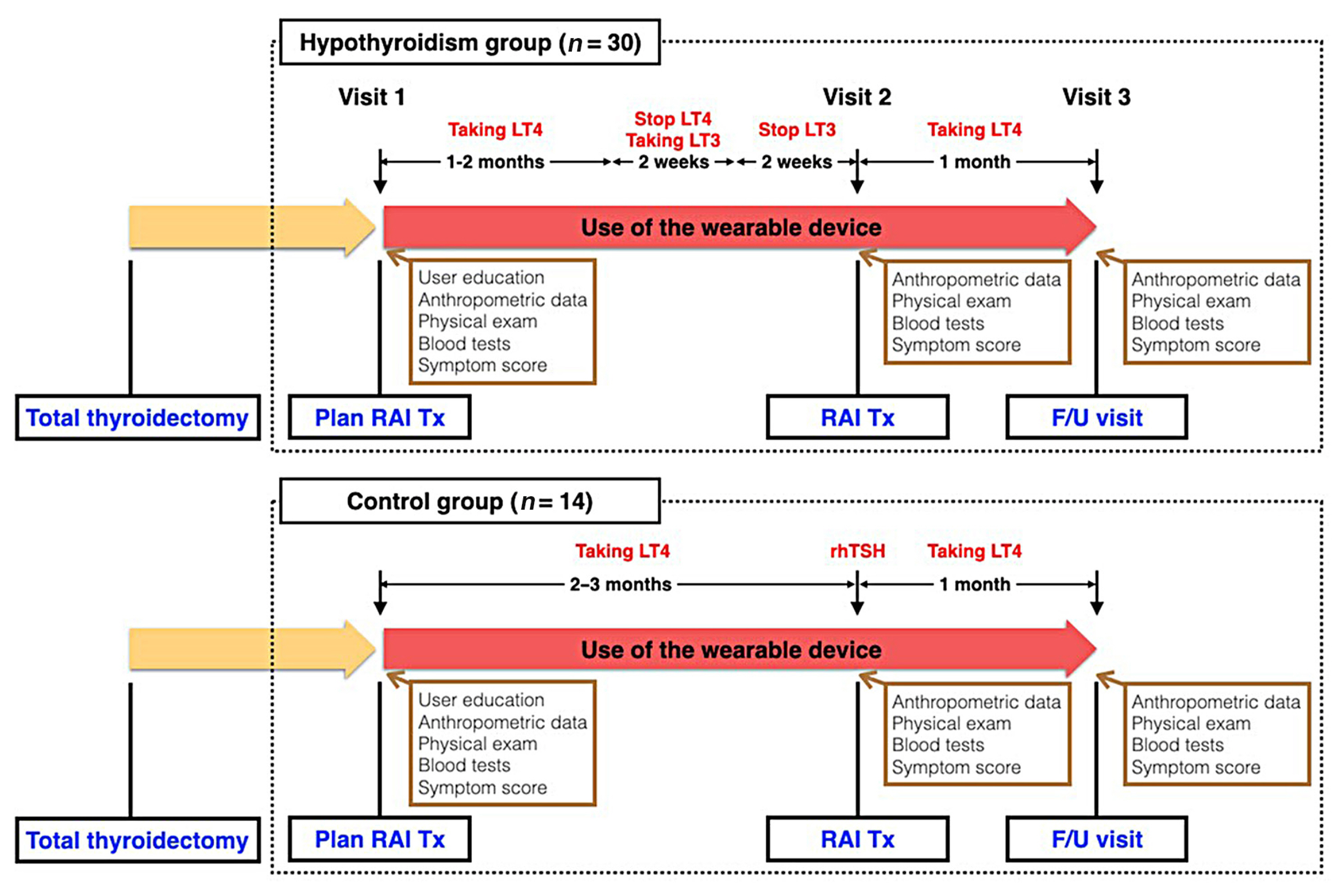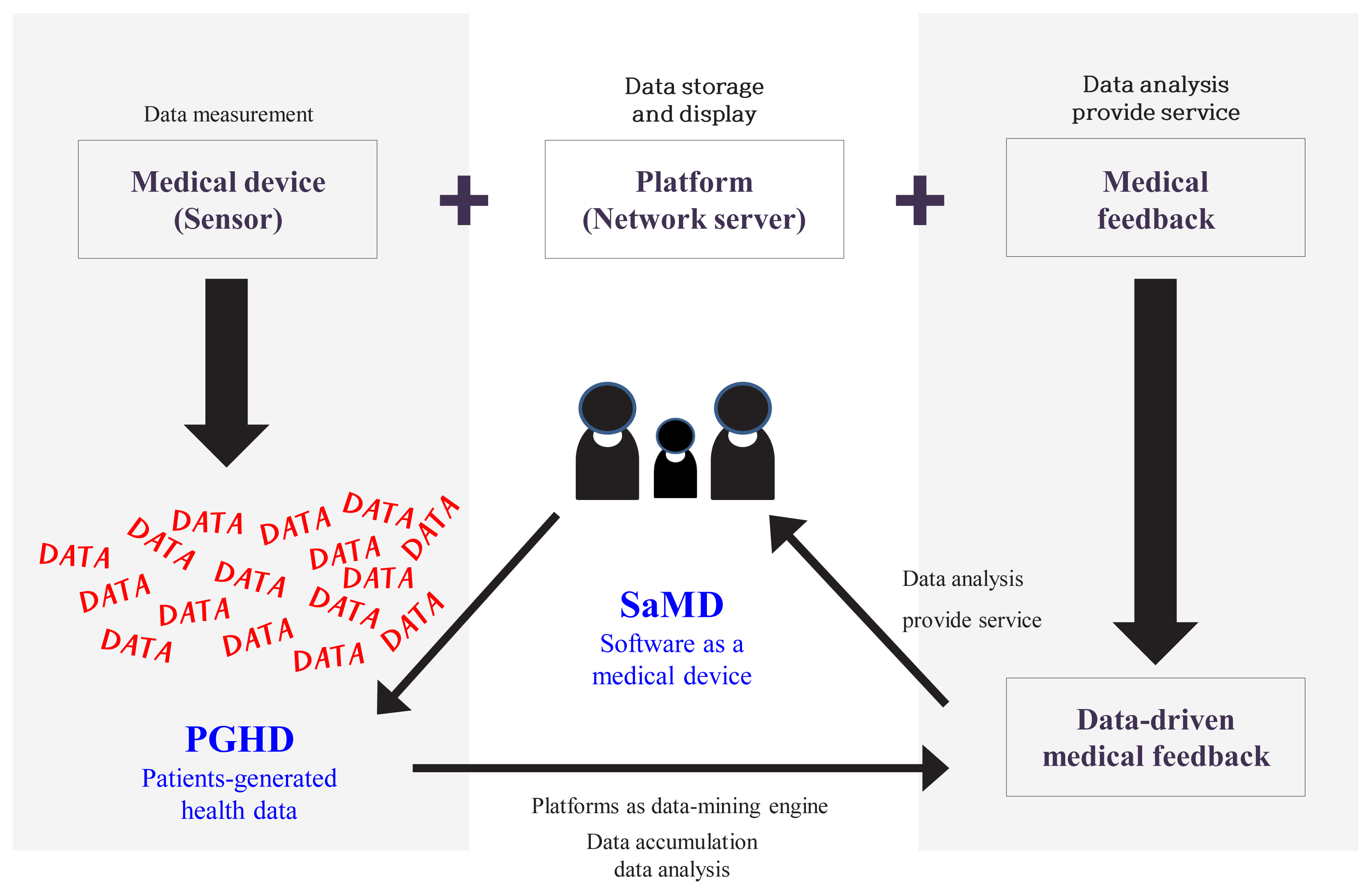Search
- Page Path
- HOME > Search
- Thyroid
- Association between Thyroid Function and Heart Rate Monitored by Wearable Devices in Patients with Hypothyroidism
- Ki-Hun Kim, Juhui Lee, Chang Ho Ahn, Hyeong Won Yu, June Young Choi, Ho-Young Lee, Won Woo Lee, Jae Hoon Moon
- Endocrinol Metab. 2021;36(5):1121-1130. Published online October 21, 2021
- DOI: https://doi.org/10.3803/EnM.2021.1216

- 5,465 View
- 158 Download
- 4 Web of Science
- 3 Crossref
-
 Abstract
Abstract
 PDF
PDF Supplementary Material
Supplementary Material PubReader
PubReader  ePub
ePub - Background
Heart rate (HR) monitored by a wearable device (WD) has demonstrated its clinical feasibility for thyrotoxicosis subjects. However, the association of HR monitored by wearables with hypothyroidism has not been examined. We assessed the association between serum thyroid hormone concentration and three WD-HR parameters in hypothyroid subjects.
Methods
Forty-four subjects scheduled for radioactive iodine therapy (RAI Tx) after thyroid cancer surgery were included. Thirty subjects were prepared for RAI Tx by thyroid hormone withdrawal (hypothyroidism group) and 14 subjects by recombinant human thyrotropin (control group). Three WD-HR parameters were calculated from the HR data collected during rest, during sleep, and from 2:00 AM to 6:00 AM, respectively. We analyzed the changes in conventionally measured resting HR (On-site rHR) and WDHR parameters relative to thyroid hormone levels.
Results
Serum free thyroxine (T4) levels, On-site rHR, and WD-HR parameters were lower in the hypothyroid group than in the control group at the time of RAI Tx. WD-HR parameters also reflected minute changes in free T4 levels. A decrease in On-site rHR and WD-HR parameters by one standard deviation (On-site rHR, approximately 12 bpm; WD-HR parameters, approximately 8 bpm) was associated with a 0.2 ng/dL decrease in free T4 levels (P<0.01) and a 2-fold increase of the odds ratio of hypothyroidism (P<0.01). WD-HR parameters displayed a better goodness-of-fit measure (lower quasi-information criterion value) than On-site rHR in predicting the hypothyroidism.
Conclusion
This study identified WD-HR parameters as informative and easy-to-measure biomarkers to predict hypothyroidism. -
Citations
Citations to this article as recorded by- Application of wearables for remote monitoring of oncology patients: A scoping review
Katharina Cloß, Marlo Verket, Dirk Müller-Wieland, Nikolaus Marx, Katharina Schuett, Edgar Jost, Martina Crysandt, Fabian Beier, Tim H Brümmendorf, Guido Kobbe, Julia Brandts, Malte Jacobsen
DIGITAL HEALTH.2024;[Epub] CrossRef - Thyroid hormone action during GABAergic neuron maturation: The quest for mechanisms
Sabine Richard, Juan Ren, Frédéric Flamant
Frontiers in Endocrinology.2023;[Epub] CrossRef - A machine learning-assisted system to predict thyrotoxicosis using patients’ heart rate monitoring data: a retrospective cohort study
Kyubo Shin, Jongchan Kim, Jaemin Park, Tae Jung Oh, Sung Hye Kong, Chang Ho Ahn, Joon Ho Moon, Min Joo Kim, Jae Hoon Moon
Scientific Reports.2023;[Epub] CrossRef
- Application of wearables for remote monitoring of oncology patients: A scoping review

- Diabetes
- Lessons from Use of Continuous Glucose Monitoring Systems in Digital Healthcare
- Hun-Sung Kim, Kun-Ho Yoon
- Endocrinol Metab. 2020;35(3):541-548. Published online September 22, 2020
- DOI: https://doi.org/10.3803/EnM.2020.675

- 6,909 View
- 184 Download
- 7 Web of Science
- 10 Crossref
-
 Abstract
Abstract
 PDF
PDF PubReader
PubReader  ePub
ePub - We live in a digital world where a variety of wearable medical devices are available. These technologies enable us to measure our health in our daily lives. It is increasingly possible to manage our own health directly through data gathered from these wearable devices. Likewise, healthcare professionals have also been able to indirectly monitor patients’ health. Healthcare professionals have accepted that digital technologies will play an increasingly important role in healthcare. Wearable technologies allow better collection of personal medical data, which healthcare professionals can use to improve the quality of healthcare provided to the public. The use of continuous glucose monitoring systems (CGMS) is the most representative and desirable case in the adoption of digital technology in healthcare. Using the case of CGMS and examining its use from the perspective of healthcare professionals, this paper discusses the necessary adjustments required in clinical practices. There is a need for various stakeholders, such as medical staff, patients, industry partners, and policy-makers, to utilize and harness the potential of digital technology.
-
Citations
Citations to this article as recorded by- Managing Talent Among Healthcare Human Resource: Strategies for a New Normal
Divya Aggarwal, Vijit Chaturvedi, Anandhi Ramachandran, Taniya Singh
Journal of Health Management.2024;[Epub] CrossRef - Current status of remote collaborative care for hypertension in medically underserved areas
Seo Yeon Baik, Kyoung Min Kim, Hakyoung Park, Jiwon Shinn, Hun-Sung Kim
Cardiovascular Prevention and Pharmacotherapy.2024; 6(1): 33. CrossRef - Using medical big data for clinical research and legal considerations for the protection of personal information: the double-edged sword
Raeun Kim, Jiwon Shinn, Hun-Sung Kim
Cardiovascular Prevention and Pharmacotherapy.2024; 6(1): 8. CrossRef - Diverse perspectives on remote collaborative care for chronic disease management
Seo Yeon Baik, Hakyoung Park, Jiwon Shinn, Hun-Sung Kim
Cardiovascular Prevention and Pharmacotherapy.2024; 6(1): 26. CrossRef - Patent analysis of digital sensors for continuous glucose monitoring
Olena Litvinova, Magdalena Eitenberger, Aylin Bilir, Andy Wai Kan Yeung, Emil D. Parvanov, ArunSundar MohanaSundaram, Jarosław Olav Horbańczuk, Atanas G. Atanasov, Harald Willschke
Frontiers in Public Health.2023;[Epub] CrossRef - Personalized Nutrition 2020: Proceedings from the American Nutrition Association’s 61st Annual Summit
Victoria A. Y. Behm, Corinne L. Bush
Journal of the American College of Nutrition.2021; 40(4): 397. CrossRef - Towards Telemedicine Adoption in Korea: 10 Practical Recommendations for Physicians
Hun-Sung Kim
Journal of Korean Medical Science.2021;[Epub] CrossRef - Perceptron: Basic Principles of Deep Neural Networks
Eung-Hee Kim, Hun-Sung Kim
Cardiovascular Prevention and Pharmacotherapy.2021; 3(3): 64. CrossRef - Lack of Acceptance of Digital Healthcare in the Medical Market: Addressing Old Problems Raised by Various Clinical Professionals and Developing Possible Solutions
Jong Il Park, Hwa Young Lee, Hyunah Kim, Jisan Lee, Jiwon Shinn, Hun-Sung Kim
Journal of Korean Medical Science.2021;[Epub] CrossRef - Digital health and diabetes: experience from India
Jothydev Kesavadev, Gopika Krishnan, Viswanathan Mohan
Therapeutic Advances in Endocrinology and Metabolism.2021; 12: 204201882110546. CrossRef
- Managing Talent Among Healthcare Human Resource: Strategies for a New Normal

- Thyroid
- Digital Medicine in Thyroidology: A New Era of Managing Thyroid Disease
- Jae Hoon Moon, Steven R. Steinhubl
- Endocrinol Metab. 2019;34(2):124-131. Published online June 24, 2019
- DOI: https://doi.org/10.3803/EnM.2019.34.2.124
- 5,439 View
- 135 Download
- 8 Web of Science
- 8 Crossref
-
 Abstract
Abstract
 PDF
PDF PubReader
PubReader  ePub
ePub Digital medicine has the capacity to affect all aspects of medicine, including disease prediction, prevention, diagnosis, treatment, and post-treatment management. In the field of thyroidology, researchers are also investigating potential applications of digital technology for the thyroid disease. Recent studies using artificial intelligence (AI)/machine learning (ML) have reported reasonable performance for the classification of thyroid nodules based on ultrasonographic (US) images. AI/ML-based methods have also shown good diagnostic accuracy for distinguishing between benign and malignant thyroid lesions based on cytopathologic findings. Assistance from AI/ML methods could overcome the limitations of conventional thyroid US and fine-needle aspiration cytology. A web-based database has been developed for thyroid cancer care. In addition to its role as a nationwide registry of thyroid cancer, it is expected to serve as a clinical platform to facilitate better thyroid cancer care and as a research platform providing comprehensive disease-specific big data. Evidence has been found that biosignal monitoring with wearable devices may predict thyroid dysfunction. This real-world thyroid function monitoring could aid in the management and early detection of thyroid dysfunction. In the thyroidology field, research involving the range of digital medicine technologies and their clinical applications is expected to be even more active in the future.
-
Citations
Citations to this article as recorded by- AI in Thyroid Cancer Diagnosis: Techniques, Trends, and Future Directions
Yassine Habchi, Yassine Himeur, Hamza Kheddar, Abdelkrim Boukabou, Shadi Atalla, Ammar Chouchane, Abdelmalik Ouamane, Wathiq Mansoor
Systems.2023; 11(10): 519. CrossRef - Empirical Method for Thyroid Disease Classification Using a Machine Learning Approach
Tahir Alyas, Muhammad Hamid, Khalid Alissa, Tauqeer Faiz, Nadia Tabassum, Aqeel Ahmad, Gulnaz Afzal
BioMed Research International.2022; 2022: 1. CrossRef - Deep Learning Based Classification of Wrist Cracks from X-ray Imaging
Jahangir Jabbar, Muzammil Hussain, Hassaan Malik, Abdullah Gani, Ali Haider Khan, Muhammad Shiraz
Computers, Materials & Continua.2022; 73(1): 1827. CrossRef - Diagnostic Performance of Kwak, EU, ACR, and Korean TIRADS as Well as ATA Guidelines for the Ultrasound Risk Stratification of Non-Autonomously Functioning Thyroid Nodules in a Region with Long History of Iodine Deficiency: A German Multicenter Trial
Philipp Seifert, Simone Schenke, Michael Zimny, Alexander Stahl, Michael Grunert, Burkhard Klemenz, Martin Freesmeyer, Michael C. Kreissl, Ken Herrmann, Rainer Görges
Cancers.2021; 13(17): 4467. CrossRef - Association between Thyroid Function and Heart Rate Monitored by Wearable Devices in Patients with Hypothyroidism
Ki-Hun Kim, Juhui Lee, Chang Ho Ahn, Hyeong Won Yu, June Young Choi, Ho-Young Lee, Won Woo Lee, Jae Hoon Moon
Endocrinology and Metabolism.2021; 36(5): 1121. CrossRef - Deep Learning based Classification of Thyroid Cancer using Different Medical Imaging Modalities : A Systematic Review
Maheen Ilyas, Hassaan Malik, Muhammad Adnan, Umair Bashir, Wajahat Anwaar Bukhari, Muhammad Imran Ali Khan, Adnan Ahmad
VFAST Transactions on Software Engineering.2021; 9(4): 1. CrossRef - Ultrasound risk stratification systems for thyroid nodule: between lights and shadows, we are moving towards a new era
Pierpaolo Trimboli, Cosimo Durante
Endocrine.2020; 69(1): 1. CrossRef - Associations of Thyroid Hormones and Resting Heart Rate in Patients
Referred to Coronary Angiography
Eva Steinberger, Stefan Pilz, Christian Trummer, Verena Theiler-Schwetz, Markus Reichhartinger, Thomas Benninger, Marlene Pandis, Oliver Malle, Martin H. Keppel, Nicolas Verheyen, Martin R. Grübler, Jakob Voelkl, Andreas Meinitzer, Winfried März
Hormone and Metabolic Research.2020; 52(12): 850. CrossRef
- AI in Thyroid Cancer Diagnosis: Techniques, Trends, and Future Directions


 KES
KES

 First
First Prev
Prev



